#api with google sheets
Explore tagged Tumblr posts
Text
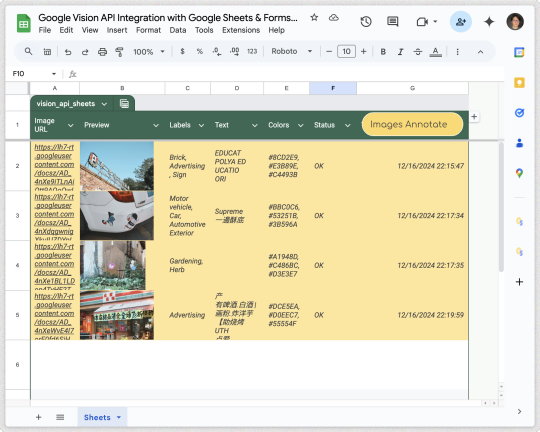
#ashtonfei#vision ai#vision api#google vision#text detection#image labeling#google apps script#google sheets
0 notes
Text
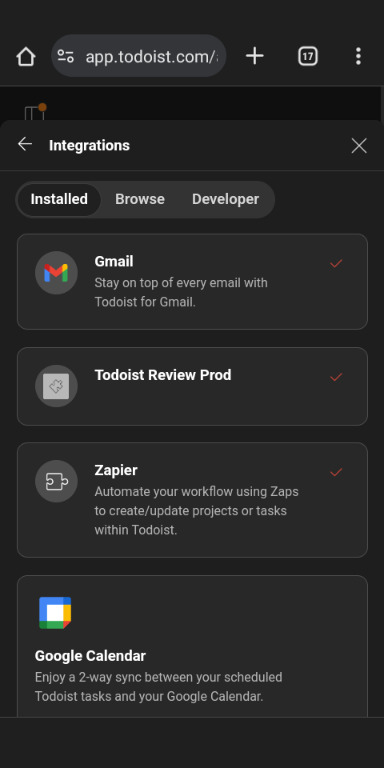
1 note
·
View note
Text
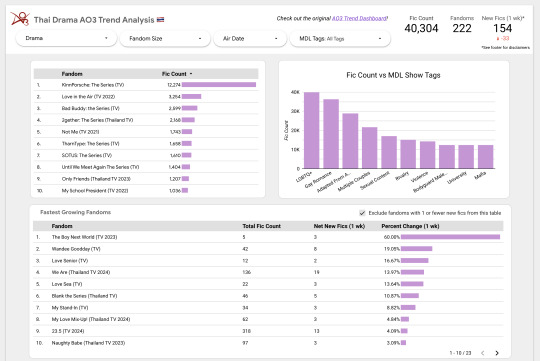
Introducing the Thai Drama AO3 Trends Dashboard! (Beta) 🇹🇭
Over the last several weeks or so I've been building an auto-scraping setup to get AO3 stats on Thai Drama fandoms. Now I finally have it ready to share out!
Take a look if you're interested and let me know what you think :)
(More details and process info under the cut.)
Main Features
This dashboard pulls in data about the quantity of Thai Drama fics over time.

Using filters, it allows you to break that data down by drama, fandom size, air date, and a select number of MyDramaList tags.
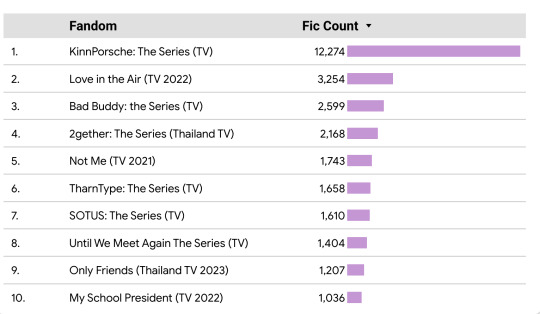
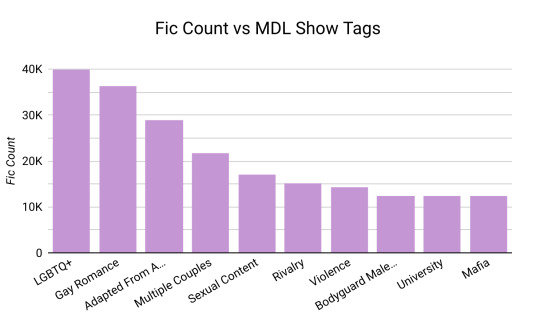
You can also see which fandoms have had the most new fics added on a weekly basis, plus the growth as a percentage of the total.
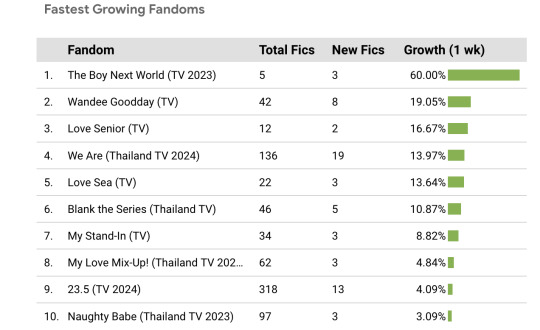
My hope is that this will make it easier to compare Thai Drama fandoms as a collective and pick out trends that otherwise might be difficult to see in an all-AO3 dataset.
Process
Okay -- now for the crunchy stuff...
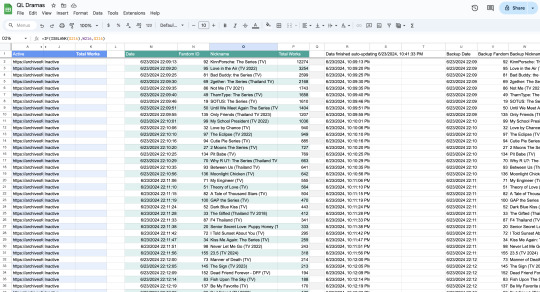
Scraping 🔎
Welcome to the most over-complicated Google Sheets spreadsheet ever made.
I used Google Sheets formulas to scrape certain info from each Thai Drama tag, and then I wrote some app scripts to refresh the data once a day. There are 5 second breaks between the refreshes for each fandom to avoid overwhelming AO3's servers.
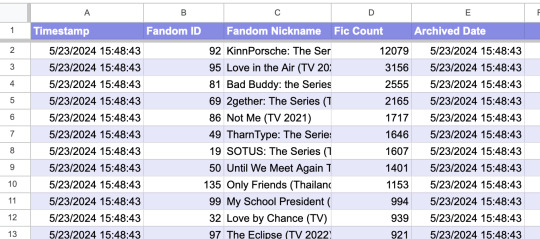
Archiving 📁
Once all the data is scraped, it gets transferred to a different Archive spreadsheet that feeds directly into the data dashboard. The dashboard will update automatically when new data is added to the spreadsheet, so I don't have to do anything manually.

Show Metadata 📊
I decided to be extra and use a (currently unofficial) MyDramaList API to pull in data about each show, such as the year it came out and the MDL tags associated with it. Fun! I might pull in even more info in the future if the mood strikes me.
Bonus - Pan-Fandom AO3 Search
Do you ever find it a bit tedious to have like, 15 different tabs open for the shows you're currently reading fic for?
While making this dash, I also put together this insane URL that basically serves as a "feed" for any and all new Thai drama fics. You can check it out here! It could be useful if you like checking for new fics in multiple fandoms at once. :)
Other Notes
Consider this dashboard the "beta" version -- please let me know if you notice anything that looks off. Also let me know if there are any fandoms missing! Thanks for checking it out!
The inspiration for this dashboard came from @ao3-anonymous 's AO3 Fandom Trend Analysis Dashboard, which I used as a jumping off point for my own data dash. Please give them some love <3
#in which i am the biggest nerd ever#thai bl#thai drama#lgbt drama#ql drama#data science#acafan#fandom data visualization#fanfiction data
287 notes
·
View notes
Text
LIST: iOS SHORTCUTS
• Spotify to MP3 | "Download Spotify tracks to MP3." • All Media Downloader | "This shortcut helps you download content from social media apps." • Web Services | "Customise the internet for you." • Better GIF Maker | "Convert videos and live photos to GIFs at highest quality using ffmpeg" • Water Eject | "Powerful water ejection system." • Paywall and Cookie Bypass | "Bypass website paywalls and cookies." • iUtilities | "The only shortcut you’ll need" • Reverse Image Search | "Search by image instead of keywords" • Google Translate | "Quickly translate using the Google Translate API" • iTweak Final Version | "A Jailbreak Alternative With Multiple Features!"
...WHAT ARE SHORTCUTS?
for those unaware: the pre-installed Shortcuts app on iOS/macOS/iPadOS can potentially be a life-changing application in regards to digital productivity.
it's utilized as a hub for your collection of shortcuts and automations. shortcuts allow for just a single click—which many times is conveniently incorporated onto your "share" sheet option panel—to execute one or multiple actions; automations are chosen commands that run at specific/relative times of day without prompt.
people tend to overlook the Shortcuts app due to its available "gallery" of shortcuts being rather limited... with the only other option provided being to build these desired actions yourself, which requires the skill of digital coding. however! that's where RoutineHub comes in: it's a website allowing users to share their own complex shortcuts, free of charge, and has a large selection to choose from.
RoutineHub: Shortcuts {by Popularity}
#smart technology#digital productivity#life hacks#productivity#shortcuts#smart living#automations#iOS#macOS#iPadOS#technology#routinehub#g#link#text#ref
162 notes
·
View notes
Note
Hello, fellow compsci enthusiast. I am trying to scrape together motivation to work on the vote graph script for Yuno's trial.
I mean, I already have the means to gather the numbers. I just need to get the API to work to put the numbers on Google Sheets so the graphs can work in real time. :')
hello!!
owahhh best of luck, kyanako!! we were actually learning about web programming and api today in class lol so yippee!!
o77 yuno graph WAH
2 notes
·
View notes
Text
Hey all, small update on the r/InfinityTrain archive efforts here.
As it turns out, the mods on the subreddit have opened it back up to the public and I am no longer the only person allowed to view it, so you can go and check it out now.
That being said, with tomorrow being the start of the API changes, it’d still be in your best interests to archive what you can and want to while Reddit still works. In the meantime, since it’s still the last day of Pride month at the time of starting this draft and because I’ve managed to do a considerable amount of work without yet losing steam, I’m happy to share a peek at the current progress on my subreddit archive:
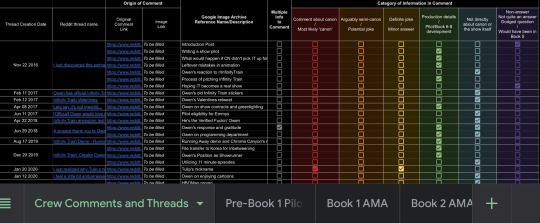
As you can see, I’m still going to finish my archiving of what I can, as who knows what may happen to the original information sources.
Especially because Twitter now requires you to have an account to do anything - including merely browsing and seeing posts - and who knows whether embed support on other sites will be going away too.
In other words, if you want to still have a guaranteed way to check info from the Twitter accounts of the crew but don’t want to make an account/in case Twitter gets royally screwed up, it is incredibly important to document any and all concept art, post threads, and links shared by the Infinity Train crew.
In fact, I have set up a Google drive folder to consolidate efforts into one place for all who wants to help with this task below:
Inside, I have set up two folders: posts by the crew, and noteworthy fan art/analysis by fans that the crew have taken particular note of. And to help with organizing all the links and information together, I have set up the simplified google sheet below:
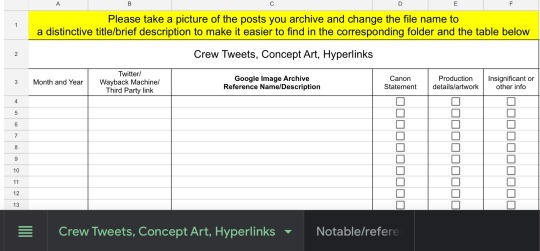
For the process of organizing, here’s a general outline of how archiving can be done:
Find the Twitter post you want to archive, whether it’s in a Discord server, on the Wayback Machine website (since Owen mass deleted his tweets often),
Copy the link to the Google sheet with - if you can - the month and year the post was created
Take a picture of the full post/decent chunks of a Twitter thread
If possible, change the file name of the picture to a title or brief description outlining the content within the post
Upload the photo to the respective subfolder and type the file name in the respective Google Sheet
Now, I have a few additional docs and subfolders than these key ones, but I hope that the drive is overall easy to navigate and understand, and here’s to saving Infinity Train fandom history for all to see and know that we were here!
50 notes
·
View notes
Text
Everytime i hear news about POGOs feeling ko nag kaka justice na yung trauma na inabot ko nung 2019 Alam kong madami yung mawawalan ng trabaho but Filipinos deserve better.
- Most of the Chinese na nagwowork sa POGO are not using their real name pag pasok ng Pinas. Kaya takot na takot sila lumabas even sa mall kase baka ma question yung pagkatao nila. Kaya di na ko nagtaka kung pano nakalusot si Mayor Alice Guo. Some of them are using an English name.
- Uso kidnapping sa kanila and kapwa Chinese pa nila yung gumagawa nun kase wala naman silang bank account and puro lang sila cash pag sumasahod. 150k+ sahod nila kase once a month lang rd nila. Pero sahod na yun ng limang pinoy sa POGO.
- I won’t forget how disrespectful yung mga Chinese na kawork namin na lalaki. Most of them mas gustong babae yung partner ng Chinese on shift kase nakakapikon talaga yung ugali nila and prone sila sa away. Naranasan kong may nagsusuntukan sa harap ko while on shift. Very unprofessional. Mga bastos pa, they are sexualizing girls na kawork nila including us.
- Mostly na kinukuha nila is mga Chinese nationals na farmers, mga di nakapag aral, and laki sa hirap. Nothing wrong with being a farmer pero i would say na yung iba talaga sa kanila, wala talagang modo and halatang walang pinag aralan.
- Mapanakit sila. Nung naka gy shift ako that time may isang Chinese na trip talaga ko saktan. Habang naka break ako sa labas ng office dinaganan niya yung hita ko ng walang rason and sobrang nagpasa siya. Pinalagpas ko yun kase paborito yun ng boss. Take note na lalaki siya. There are times na bigla nya iuurong yung lamesa na kahoy minsan pag trip nya and babatuhin niya ko ng crumpled paper for no reason. He also used spoon sa balikat ko to call my attention habang kumakain ako ng lomi.
- Tatanggalin ka nila kapag may mistakes ka sa transaction. Puro pera from gambling yung need naming isend from diff banks and may isang Chinese dun na ang lala ng galit sakin. He mentioned thru google translate na malas daw ako. Shuta never ako nagka mistake sa transactions ko kase sobra akong nag iingat. Kalahating araw niya kong pinagmumura in Chinese dahil lang ako partner nya that day and hindi gumana yung pc nya.
- 12 hrs shift mo with 30 mins lunch. Literal na para kang OFW vibe pag andun ka. Yung feeling na alipin ka sa sarili mong bansa. Yung boss namin na Chinese nagagalit ng walang dahilan. Very unreasonable. Nahuli nya kong nagsasalamin and shuta sinigawan nya ko. Yung nag mentor naman sakin na babae, napuno na kase kumuha lang siya ng tissue sa box ang dami ng sinabi nung Chinese. Haha Pinakyuhan ni ate geraldine yung boss namin sabay Resign kinabukasan.
- Kung pera lang ang usapan I would say na eto yung pinaka madaling work na ginawa ko. Kase encoder kalang and same excel sheet lang gagamitin mo everyday. Pero wala siyang growth kase most of the time naka tunganga ka lang.
- I hate my experience in POGO given that 2 mos lang naman tinagal ko dahil gusto ko magpahinga sa BPO, mas ok na kong sigawan ng mga kano sa calls kesa maging alipin ng mga Chinese. Working environment there was awful for me. And inhumane. It was an eyeopener for me na wag magpa api sa sariling mong bansa.
- Some had good experiences with POGO, given that pumapantay at humihigit pa nga sa sahod ng mga bpo workers, pero sana hindi nila ma experience yung mga naexperience ko.
- There are still good Chinese na nakilala ako. Some of them kumapit na lang siguro sa ganitong trabaho to help their families in China. Sila lang yung mga pinagpepray ko na sana ok pa rin up until now.
PERO SATIN PA RIN ANG WEST PHILIPPINES SEA.
11 notes
·
View notes
Text
Why Tableau is Essential in Data Science: Transforming Raw Data into Insights

Data science is all about turning raw data into valuable insights. But numbers and statistics alone don’t tell the full story—they need to be visualized to make sense. That’s where Tableau comes in.
Tableau is a powerful tool that helps data scientists, analysts, and businesses see and understand data better. It simplifies complex datasets, making them interactive and easy to interpret. But with so many tools available, why is Tableau a must-have for data science? Let’s explore.
1. The Importance of Data Visualization in Data Science
Imagine you’re working with millions of data points from customer purchases, social media interactions, or financial transactions. Analyzing raw numbers manually would be overwhelming.
That’s why visualization is crucial in data science:
Identifies trends and patterns – Instead of sifting through spreadsheets, you can quickly spot trends in a visual format.
Makes complex data understandable – Graphs, heatmaps, and dashboards simplify the interpretation of large datasets.
Enhances decision-making – Stakeholders can easily grasp insights and make data-driven decisions faster.
Saves time and effort – Instead of writing lengthy reports, an interactive dashboard tells the story in seconds.
Without tools like Tableau, data science would be limited to experts who can code and run statistical models. With Tableau, insights become accessible to everyone—from data scientists to business executives.
2. Why Tableau Stands Out in Data Science
A. User-Friendly and Requires No Coding
One of the biggest advantages of Tableau is its drag-and-drop interface. Unlike Python or R, which require programming skills, Tableau allows users to create visualizations without writing a single line of code.
Even if you’re a beginner, you can:
✅ Upload data from multiple sources
✅ Create interactive dashboards in minutes
✅ Share insights with teams easily
This no-code approach makes Tableau ideal for both technical and non-technical professionals in data science.
B. Handles Large Datasets Efficiently
Data scientists often work with massive datasets—whether it’s financial transactions, customer behavior, or healthcare records. Traditional tools like Excel struggle with large volumes of data.
Tableau, on the other hand:
Can process millions of rows without slowing down
Optimizes performance using advanced data engine technology
Supports real-time data streaming for up-to-date analysis
This makes it a go-to tool for businesses that need fast, data-driven insights.
C. Connects with Multiple Data Sources
A major challenge in data science is bringing together data from different platforms. Tableau seamlessly integrates with a variety of sources, including:
Databases: MySQL, PostgreSQL, Microsoft SQL Server
Cloud platforms: AWS, Google BigQuery, Snowflake
Spreadsheets and APIs: Excel, Google Sheets, web-based data sources
This flexibility allows data scientists to combine datasets from multiple sources without needing complex SQL queries or scripts.
D. Real-Time Data Analysis
Industries like finance, healthcare, and e-commerce rely on real-time data to make quick decisions. Tableau’s live data connection allows users to:
Track stock market trends as they happen
Monitor website traffic and customer interactions in real time
Detect fraudulent transactions instantly
Instead of waiting for reports to be generated manually, Tableau delivers insights as events unfold.
E. Advanced Analytics Without Complexity
While Tableau is known for its visualizations, it also supports advanced analytics. You can:
Forecast trends based on historical data
Perform clustering and segmentation to identify patterns
Integrate with Python and R for machine learning and predictive modeling
This means data scientists can combine deep analytics with intuitive visualization, making Tableau a versatile tool.
3. How Tableau Helps Data Scientists in Real Life
Tableau has been adopted by the majority of industries to make data science more impactful and accessible. This is applied in the following real-life scenarios:
A. Analytics for Health Care
Tableau is deployed by hospitals and research institutions for the following purposes:
Monitor patient recovery rates and predict outbreaks of diseases
Analyze hospital occupancy and resource allocation
Identify trends in patient demographics and treatment results
B. Finance and Banking
Banks and investment firms rely on Tableau for the following purposes:
✅ Detect fraud by analyzing transaction patterns
✅ Track stock market fluctuations and make informed investment decisions
✅ Assess credit risk and loan performance
C. Marketing and Customer Insights
Companies use Tableau to:
✅ Track customer buying behavior and personalize recommendations
✅ Analyze social media engagement and campaign effectiveness
✅ Optimize ad spend by identifying high-performing channels
D. Retail and Supply Chain Management
Retailers leverage Tableau to:
✅ Forecast product demand and adjust inventory levels
✅ Identify regional sales trends and adjust marketing strategies
✅ Optimize supply chain logistics and reduce delivery delays
These applications show why Tableau is a must-have for data-driven decision-making.
4. Tableau vs. Other Data Visualization Tools
There are many visualization tools available, but Tableau consistently ranks as one of the best. Here’s why:
Tableau vs. Excel – Excel struggles with big data and lacks interactivity; Tableau handles large datasets effortlessly.
Tableau vs. Power BI – Power BI is great for Microsoft users, but Tableau offers more flexibility across different data sources.
Tableau vs. Python (Matplotlib, Seaborn) – Python libraries require coding skills, while Tableau simplifies visualization for all users.
This makes Tableau the go-to tool for both beginners and experienced professionals in data science.
5. Conclusion
Tableau has become an essential tool in data science because it simplifies data visualization, handles large datasets, and integrates seamlessly with various data sources. It enables professionals to analyze, interpret, and present data interactively, making insights accessible to everyone—from data scientists to business leaders.
If you’re looking to build a strong foundation in data science, learning Tableau is a smart career move. Many data science courses now include Tableau as a key skill, as companies increasingly demand professionals who can transform raw data into meaningful insights.
In a world where data is the driving force behind decision-making, Tableau ensures that the insights you uncover are not just accurate—but also clear, impactful, and easy to act upon.
#data science course#top data science course online#top data science institute online#artificial intelligence course#deepseek#tableau
3 notes
·
View notes
Text
Top 5 Selling Odoo Modules.
In the dynamic world of business, having the right tools can make all the difference. For Odoo users, certain modules stand out for their ability to enhance data management and operations. To optimize your Odoo implementation and leverage its full potential.
That's where Odoo ERP can be a life savior for your business. This comprehensive solution integrates various functions into one centralized platform, tailor-made for the digital economy.
Let’s drive into 5 top selling module that can revolutionize your Odoo experience:
Dashboard Ninja with AI, Odoo Power BI connector, Looker studio connector, Google sheets connector, and Odoo data model.
1. Dashboard Ninja with AI:
Using this module, Create amazing reports with the powerful and smart Odoo Dashboard ninja app for Odoo. See your business from a 360-degree angle with an interactive, and beautiful dashboard.
Some Key Features:
Real-time streaming Dashboard
Advanced data filter
Create charts from Excel and CSV file
Fluid and flexible layout
Download Dashboards items
This module gives you AI suggestions for improving your operational efficiencies.
2. Odoo Power BI Connector:
This module provides a direct connection between Odoo and Power BI Desktop, a Powerful data visualization tool.
Some Key features:
Secure token-based connection.
Proper schema and data type handling.
Fetch custom tables from Odoo.
Real-time data updates.
With Power BI, you can make informed decisions based on real-time data analysis and visualization.
3. Odoo Data Model:
The Odoo Data Model is the backbone of the entire system. It defines how your data is stored, structured, and related within the application.
Key Features:
Relations & fields: Developers can easily find relations ( one-to-many, many-to-many and many-to-one) and defining fields (columns) between data tables.
Object Relational mapping: Odoo ORM allows developers to define models (classes) that map to database tables.
The module allows you to use SQL query extensions and download data in Excel Sheets.
4. Google Sheet Connector:
This connector bridges the gap between Odoo and Google Sheets.
Some Key features:
Real-time data synchronization and transfer between Odoo and Spreadsheet.
One-time setup, No need to wrestle with API’s.
Transfer multiple tables swiftly.
Helped your team’s workflow by making Odoo data accessible in a sheet format.
5. Odoo Looker Studio Connector:
Looker studio connector by Techfinna easily integrates Odoo data with Looker, a powerful data analytics and visualization platform.
Some Key Features:
Directly integrate Odoo data to Looker Studio with just a few clicks.
The connector automatically retrieves and maps Odoo table schemas in their native data types.
Manual and scheduled data refresh.
Execute custom SQL queries for selective data fetching.
The Module helped you build detailed reports, and provide deeper business intelligence.
These Modules will improve analytics, customization, and reporting. Module setup can significantly enhance your operational efficiency. Let’s embrace these modules and take your Odoo experience to the next level.
Need Help?
I hope you find the blog helpful. Please share your feedback and suggestions.
For flawless Odoo Connectors, implementation, and services contact us at
[email protected] Or www.techneith.com
#odoo#powerbi#connector#looker#studio#google#microsoft#techfinna#ksolves#odooerp#developer#web developers#integration#odooimplementation#crm#odoointegration#odooconnector
4 notes
·
View notes
Text
The open internet once seemed inevitable. Now, as global economic woes mount and interest rates climb, the dream of the 2000s feels like it’s on its last legs. After abruptly blocking access to unregistered users at the end of last month, Elon Musk announced unprecedented caps on the number of tweets—600 for those of us who aren’t paying $8 a month—that users can read per day on Twitter. The move follows the platform’s controversial choice to restrict third-party clients back in January.
This wasn’t a standalone event. Reddit announced in April that it would begin charging third-party developers for API calls this month. The Reddit client Apollo would have to pay more than $20 million a year under new pricing, so it closed down, triggering thousands of subreddits to go dark in protest against Reddit’s new policy. The company went ahead with its plan anyway.
Leaders at both companies have blamed this new restrictiveness on AI companies unfairly benefitting from open access to data. Musk has said that Twitter needs rate limits because AI companies are scraping its data to train large language models. Reddit CEO Steve Huffman has cited similar reasons for the company’s decision to lock down its API ahead of a potential IPO this year.
These statements mark a major shift in the rhetoric and business calculus of Silicon Valley. AI serves as a convenient boogeyman, but it is a distraction from a more fundamental pivot in thinking. Whereas open data and protocols were once seen as the critical cornerstone of successful internet business, technology leaders now see these features as a threat to the continued profitability of their platforms.
It wasn’t always this way. The heady days of Web 2.0 were characterized by a celebration of the web as a channel through which data was abundant and widely available. Making data open through an API or some other means was considered a key way to increase a company’s value. Doing so could also help platforms flourish as developers integrated the data into their own apps, users enriched datasets with their own contributions, and fans shared products widely across the web. The rapid success of sites like Google Maps—which made expensive geospatial data widely available to the public for the first time—heralded an era where companies could profit through free, mass dissemination of information.
“Information Wants To Be Free” became a rallying cry. Publisher Tim O’Reilly would champion the idea that business success in Web 2.0 depended on companies “disagreeing with the consensus” and making data widely accessible rather than keeping it private. Kevin Kelly marveled in WIRED in 2005 that “when a company opens its databases to users … [t]he corporation’s data becomes part of the commons and an invitation to participate. People who take advantage of these capabilities are no longer customers; they’re the company’s developers, vendors, skunk works, and fan base.” Investors also perceived the opportunity to generate vast wealth. Google was “most certainly the standard bearer for Web 2.0,” and its wildly profitable model of monetizing free, open data was deeply influential to a whole generation of entrepreneurs and venture capitalists.
Of course, the ideology of Web 2.0 would not have evolved the way it did were it not for the highly unusual macroeconomic conditions of the 2000s and early 2010s. Thanks to historically low interest rates, spending money on speculative ventures was uniquely possible. Financial institutions had the flexibility on their balance sheets to embrace the idea that the internet reversed the normal laws of commercial gravity: It was possible for a company to give away its most valuable data and still get rich quick. In short, a zero interest-rate policy, or ZIRP, subsidized investor risk-taking on the promise that open data would become the fundamental paradigm of many Google-scale companies, not just a handful.
Web 2.0 ideologies normalized much of what we think of as foundational to the web today. User tagging and sharing features, freely syndicated and embeddable links to content, and an ecosystem of third-party apps all have their roots in the commitments made to build an open web. Indeed, one of the reasons that the recent maneuvers of Musk and Huffman seem so shocking is that we have come to expect data will be widely and freely available, and that platforms will be willing to support people that build on it.
But the marriage between the commercial interests of technology companies and the participatory web has always been one of convenience. The global campaign by central banks to curtail inflation through aggressive interest rate hikes changes the fundamental economics of technology. Rather than facing a landscape of investors willing to buy into a hazy dream of the open web, leaders like Musk and Huffman now confront a world where clear returns need to be seen today if not yesterday.
This presages major changes ahead for the design of the internet and the rights of users. Twitter and Reddit are pioneering an approach to platform management (or mismanagement) that will likely spread elsewhere across the web. It will become increasingly difficult to access content without logging in, verifying an identity, or paying a toll. User data will become less exportable and less shareable, and there will be increasingly fewer expectations that it will be preserved. Third-parties that have relied on the free flow of data online—from app-makers to journalists—will find APIs ever more expensive to access and scraping harder than ever before.
We should not let the open web die a quiet death. No doubt much of the foundational rhetoric of Web 2.0 is cringeworthy in the harsh light of 2023. But it is important to remember that the core project of building a participatory web where data can be shared, improved, critiqued, remixed, and widely disseminated by anyone is still genuinely worthwhile.
The way the global economic landscape is shifting right now creates short-sighted incentives toward closure. In response, the open web ought to be enshrined as a matter of law. New regulations that secure rights around the portability of user data, protect the continued accessibility of crucial APIs to third parties, and clarify the long-ambiguous rules surrounding scraping would all help ensure that the promise of a free, dynamic, competitive internet can be preserved in the coming decade.
For too long, advocates for the open web have implicitly relied on naive beliefs that the network is inherently open, or that web companies would serve as unshakable defenders of their stated values. The opening innings of the post-ZIRP world show how broader economic conditions have actually played the larger role in architecting how the internet looks and feels to this point. Believers in a participatory internet need to reach for stronger tools to mitigate the effects of these deep economic shifts, ensuring that openness can continue to be embedded into the spaces that we inhabit online.
WIRED Opinion publishes articles by outside contributors representing a wide range of viewpoints. Read more opinions here. Submit an op-ed at [email protected].
19 notes
·
View notes
Text

Upwork Projects: Automating Photo Labeling with Vision API and Apps Script https://upwork-projects.blogspot.com/2024/09/upwork-020.html
#google vision api#google photos#google apps script#google sheets#google cloud project#freelance#upwork#ashtonfei
0 notes
Text
obviously we don't know exactly how this is being done but from what i understand this new midjourney deal (if it even happens) is specifically about tumblr giving midjourney access to the Tumblr API, which it previously did not have. various datasets used in AI training probably already include data from Tumblr because they either scraped data from Tumblr specifically (something that is probably technically against TOS but can be done without accessing the API, also something I have personally done many times on websites like TikTok and Twitter for research) or from google (which indexes links and images posted to Tumblr that you can scrape without even going on Tumblr). The API, which I currently have access to bc of my university, specifically allows you to create a dataset from specific blogs and specific tags. This dataset for tags looks basically exactly like the tag page you or i would have access to, with only original posts showing up but with all of the metadata recorded explicitly (all info you have access to from the user interface of Tumblr itself, just not always extremely clearly). For specific blogs it does include reblogs as well, but this generally seems like a less useful way of collecting data unless you are doing research into specific users (not something i am doing). It depends on your institution what the limits of this API are of course, and it does seem a bit concerning that Tumblr internally seems to have a version that includes unanswered asks, private posts, drafts etc but through the API itself you cannot get these posts. If you choose to exclude your blog from 3rd party partners, what it seems like Tumblr is doing is just removing your original posts from being indexed in any way, so not showing up on Google, not showing up in tags, in searches etc. This means your original posts arent showing up when asking the API for all posts in a specific tag, and it probably also makes it impossible to retrieve a dataset based on your blog. This means it doesnt just exclude your posts and blog from any dataset midjourney creates (if they even take the deal), it's also excluded from the type of research i'm doing (not saying this as a guilt trip, i already have my datasets so i dont care) and it's seemingly excluded from all on-site searches by other users. it's also important to note that every single thing you can do with the Tumblr API to collect data on posts and users you could feasibly also do manually by scrolling while logged in and just writing everything down in an excel sheet.
#this isnt a Take about whether or not you should turn on that new option bc like idk which option is better personally. like im not sure#im just trying to clarify what i think is going on as someone who's used this API quite a lot
3 notes
·
View notes
Text
How to Automate Workflows with Webhooks and APIs
Manual processes waste time, create bottlenecks, and increase the risk of errors. That’s why modern businesses are turning to automation to streamline their operations—and two of the most powerful tools enabling this transformation are webhooks and APIs.
A trusted Web Development Company can help you integrate both seamlessly into your digital ecosystem, making your workflows faster, smarter, and more reliable. But how exactly do webhooks and APIs work, and how are they different? Let’s break it down.
What Are APIs?
APIs, or Application Programming Interfaces, are structured methods that allow two applications to communicate. Think of them as waiters in a restaurant—they take your request (e.g., “Get new leads from the CRM”), deliver it to the kitchen (the server), and bring back exactly what you ordered.
With APIs, your website or system can:
Pull data from third-party services (e.g., weather APIs, shipping APIs, payment gateways)
Send data to apps like Slack, HubSpot, or Google Sheets
Trigger specific actions within other platforms (e.g., creating a ticket in a helpdesk)
APIs are request-driven—they perform actions when you call or trigger them intentionally, usually on a schedule or based on events.
What Are Webhooks?
Webhooks are like real-time notifications sent automatically from one app to another when something specific happens. Instead of checking for updates repeatedly, webhooks push the update as soon as it occurs.
For example:
When someone submits a form on your website, a webhook sends that data instantly to your CRM.
When a payment is completed on Razorpay, a webhook updates the order status in your internal dashboard.
Unlike APIs, which pull data, webhooks push data the moment an event occurs.
How They Work Together
Webhooks and APIs often work hand-in-hand. Here’s a simple workflow example:
A customer makes a purchase on your eCommerce store.
The payment gateway sends a webhook to your server confirming the transaction.
Your server then uses an API to update the customer database and generate an invoice.
In short, webhooks trigger, and APIs act. Together, they form the backbone of modern workflow automation.
Popular Use Cases for Workflow Automation
A professional web development team can help automate dozens of processes using webhooks and APIs. Some common examples include:
CRM Syncing: Send leads from your website form to Salesforce or HubSpot instantly.
Email Notifications: Trigger transactional emails using SendGrid or Mailchimp when a user registers or purchases.
Slack Alerts: Post messages to a Slack channel when new support tickets are created.
Inventory Management: Auto-update stock counts across multiple sales channels like Amazon, Shopify, and WooCommerce.
Task Management: Auto-create tasks in Trello or Asana based on customer activity or support queries.
Payment Reconciliation: Receive real-time updates from Razorpay or Stripe and reflect them in your finance dashboard.
Tools and Platforms That Support Automation
Many tools today offer native support for both APIs and webhooks. Some examples include:
Zapier and Make (formerly Integromat) for no-code automation
Stripe, Razorpay, and PayPal for payment triggers
Shopify and WooCommerce for eCommerce workflows
Google Workspace APIs for document generation and sync
Airtable, Notion, and Slack for internal task automation
However, for custom workflows or enterprise-level requirements, working with a developer or agency ensures flexibility, scalability, and security.
Security & Monitoring
Since both webhooks and APIs handle sensitive data, security is critical. Top web development companies ensure:
Token-based authentication
Encrypted payloads
Retry mechanisms in case of delivery failures
Rate limiting to prevent abuse
Logging and monitoring to track workflow success or failure
With these in place, you can trust your automation to work reliably in the background while your team focuses on high-impact tasks.
Conclusion
Whether you're managing customer data, updating records, or streamlining operations across tools, APIs and webhooks offer a powerful foundation for automation. Partnering with a Web Development Company helps you design and deploy automation that’s secure, scalable, and perfectly tailored to your needs.
The result? Fewer manual tasks, fewer errors—and a digital infrastructure that runs like clockwork.
0 notes
Text
Jason Zhou – AI Builder Club March 2025: Build, Automate, and Scale with Next-Gen AI Systems
Artificial Intelligence isn’t the future anymore—it’s the present. And those who master AI tools today are the ones shaping tomorrow’s businesses, products, and customer experiences. The Jason Zhou – AI Builder Club March 2025 course is your gateway to becoming one of those pioneers.
Whether you're a developer, solopreneur, startup founder, or digital creator, the Jason Zhou – AI Builder Club March 2025 Online Program teaches you how to build, deploy, and monetize powerful AI-driven tools, agents, and workflows—all using cutting-edge no-code and low-code technologies.
What is the Jason Zhou – AI Builder Club March 2025 Program?
The Jason Zhou – AI Builder Club March 2025 Program is an advanced online learning experience created to help ambitious individuals and teams build custom AI tools for real-world application. It covers everything from AI automations to building custom GPTs and launching agent-based products.
With a focus on practical builds, the course guides you in creating market-ready AI projects. These could be:
Automated customer service agents
Content generation tools
AI-powered data dashboards
Lead generation bots
SaaS MVPs using GPT, Claude, or Gemini
Whether you’re a tech-savvy entrepreneur or someone looking to break into AI development with little coding knowledge, this course gives you a step-by-step blueprint.
Meet the Creator: Jason Zhou
Jason Zhou is a rising name in the AI builder space, known for his actionable and technical insights shared across platforms like Twitter, YouTube, and his AI community. He’s built dozens of AI agents, automated systems, and monetized tools using both open-source and commercial models like ChatGPT, Claude, Mistral, and LLM APIs.
What sets Jason apart is that he doesn’t just teach AI theory. He builds real tools, ships products, and shows you exactly how to do the same—inside the AI Builder Club March 2025 Online Course By Jason Zhou.
What Will You Learn Inside the Course?
The Jason Zhou – AI Builder Club March 2025 Online Course is designed to be hands-on and high-impact. It’s less about lectures and more about building real tools you can use or sell.
Here’s what’s covered:
🔹 Module 1: Understanding the AI Tool Stack
Overview of the current AI landscape
Choosing the right LLM: OpenAI, Claude, Gemini, Mistral
Prompt engineering and chaining logic
What makes an AI tool actually useful to users
🔹 Module 2: No-Code & Low-Code Development
Using tools like Make, Zapier, Retool, and Bubble
Creating UI/UX for AI-powered SaaS tools
Building backend logic with APIs and scripting
Hosting and scaling tools using affordable stacks
🔹 Module 3: Building Your First AI Product
Project-based learning: real GPT-powered app builds
Templates for newsletter generators, copywriting tools, and outreach bots
Integrating Google Sheets, Notion, Slack, and other apps
How to deploy your MVP in under a week
🔹 Module 4: AI Agents and Automations
Creating memory-based agents for long-term conversations
Setting up multi-step decision workflows
Building business process agents for clients
Using embeddings and vector search for smarter output
🔹 Module 5: Monetization & Launch Strategies
How to package and sell your AI tools
Finding profitable problems to solve
Jason’s launch playbook: Gumroad, Product Hunt, Twitter
Pricing models, freemium vs. paid, and building an audience
🔹 Bonuses and Extras
Live recorded sessions with community Q&A
Code snippets and project repositories
Pre-built templates to kickstart your own projects
Discord access to the AI Builder Club community
Who Should Take This Course?
The AI Builder Club March 2025 Online Program By Jason Zhou is perfect for:
✅ Indie hackers and solopreneurs who want to build and sell AI tools
✅ Developers and engineers ready to learn no-code/low-code workflows
✅ Agencies and consultants who want to offer AI services
✅ Content creators and marketers who want to automate tasks
✅ Anyone interested in launching their first AI project in weeks, not months
You don’t need deep technical skills. If you understand how to use basic tools and APIs, you can follow along and build powerful systems.
Why AI Builder Club March 2025 Is a Game-Changer
The Jason Zhou – AI Builder Club March 2025 Online Program isn’t your average “AI 101” course. It’s an execution-based masterclass for building real-world tools that deliver value and create income.
What sets it apart?
🛠 Project-Based Learning: You’ll finish the course with actual AI tools, not just notes.
🔁 Updated for March 2025: Covers the latest changes in GPT-4o, Claude 3.5, open-source models, and tool integrations.
📦 Monetization Focus: Learn not just to build—but to launch and earn.
⚙️ Template Driven: Pre-built frameworks accelerate your learning and implementation.
🤝 Community Access: Get direct feedback and support from builders just like you.
You’ll walk away with both the knowledge and the tools to launch your own AI business or automate your company’s internal operations.
Student Reviews and Results
“Before this course, I had no idea how to build with GPT. After just a few weeks, I launched a content repurposing AI tool that’s now making passive income.” “Jason makes complex workflows simple and fun. The AI Builder Club March 2025 Online Course By Jason Zhou changed the way I think about automation.” “The best course I’ve taken on practical AI applications. No fluff. Just build, ship, and launch.”
Where to Buy the Course
The Jason Zhou – AI Builder Club March 2025 Online Course is available now from trusted platforms.
👉 We recommend buying directly from ECOMKEVIN COURSE
This platform ensures secure checkout, immediate access, and all bonus material included.
Final Thoughts
AI isn’t a buzzword anymore — it’s a core skill for entrepreneurs and digital professionals. The
Artificial Intelligence isn’t the future anymore—it’s the present. And those who master AI tools today are the ones shaping tomorrow’s businesses, products, and customer experiences. The Jason Zhou – AI Builder Club March 2025 course is your gateway to becoming one of those pioneers.
Whether you're a developer, solopreneur, startup founder, or digital creator, the Jason Zhou – AI Builder Club March 2025 Online Program teaches you how to build, deploy, and monetize powerful AI-driven tools, agents, and workflows—all using cutting-edge no-code and low-code technologies.
What is the Jason Zhou – AI Builder Club March 2025 Program?
The Jason Zhou – AI Builder Club March 2025 Program is an advanced online learning experience created to help ambitious individuals and teams build custom AI tools for real-world application. It covers everything from AI automations to building custom GPTs and launching agent-based products.
With a focus on practical builds, the course guides you in creating market-ready AI projects. These could be:
Automated customer service agents
Content generation tools
AI-powered data dashboards
Lead generation bots
SaaS MVPs using GPT, Claude, or Gemini
Whether you’re a tech-savvy entrepreneur or someone looking to break into AI development with little coding knowledge, this course gives you a step-by-step blueprint.
Meet the Creator: Jason Zhou
Jason Zhou is a rising name in the AI builder space, known for his actionable and technical insights shared across platforms like Twitter, YouTube, and his AI community. He’s built dozens of AI agents, automated systems, and monetized tools using both open-source and commercial models like ChatGPT, Claude, Mistral, and LLM APIs.
What sets Jason apart is that he doesn’t just teach AI theory. He builds real tools, ships products, and shows you exactly how to do the same—inside the AI Builder Club March 2025 Online Course By Jason Zhou.
What Will You Learn Inside the Course?
The Jason Zhou – AI Builder Club March 2025 Online Course is designed to be hands-on and high-impact. It’s less about lectures and more about building real tools you can use or sell.
Here’s what’s covered:
🔹 Module 1: Understanding the AI Tool Stack
Overview of the current AI landscape
Choosing the right LLM: OpenAI, Claude, Gemini, Mistral
Prompt engineering and chaining logic
What makes an AI tool actually useful to users
🔹 Module 2: No-Code & Low-Code Development
Using tools like Make, Zapier, Retool, and Bubble
Creating UI/UX for AI-powered SaaS tools
Building backend logic with APIs and scripting
Hosting and scaling tools using affordable stacks
🔹 Module 3: Building Your First AI Product
Project-based learning: real GPT-powered app builds
Templates for newsletter generators, copywriting tools, and outreach bots
Integrating Google Sheets, Notion, Slack, and other apps
How to deploy your MVP in under a week
🔹 Module 4: AI Agents and Automations
Creating memory-based agents for long-term conversations
Setting up multi-step decision workflows
Building business process agents for clients
Using embeddings and vector search for smarter output
🔹 Module 5: Monetization & Launch Strategies
How to package and sell your AI tools
Finding profitable problems to solve
Jason’s launch playbook: Gumroad, Product Hunt, Twitter
Pricing models, freemium vs. paid, and building an audience
🔹 Bonuses and Extras
Live recorded sessions with community Q&A
Code snippets and project repositories
Pre-built templates to kickstart your own projects
Discord access to the AI Builder Club community
Who Should Take This Course?
The AI Builder Club March 2025 Online Program By Jason Zhou is perfect for:
✅ Indie hackers and solopreneurs who want to build and sell AI tools
✅ Developers and engineers ready to learn no-code/low-code workflows
✅ Agencies and consultants who want to offer AI services
✅ Content creators and marketers who want to automate tasks
✅ Anyone interested in launching their first AI project in weeks, not months
You don’t need deep technical skills. If you understand how to use basic tools and APIs, you can follow along and build powerful systems.
Why AI Builder Club March 2025 Is a Game-Changer
The Jason Zhou – AI Builder Club March 2025 Online Program isn’t your average “AI 101” course. It’s an execution-based masterclass for building real-world tools that deliver value and create income.
What sets it apart?
🛠 Project-Based Learning: You’ll finish the course with actual AI tools, not just notes.
🔁 Updated for March 2025: Covers the latest changes in GPT-4o, Claude 3.5, open-source models, and tool integrations.
📦 Monetization Focus: Learn not just to build—but to launch and earn.
⚙️ Template Driven: Pre-built frameworks accelerate your learning and implementation.
🤝 Community Access: Get direct feedback and support from builders just like you.
You’ll walk away with both the knowledge and the tools to launch your own AI business or automate your company’s internal operations.
Student Reviews and Results
“Before this course, I had no idea how to build with GPT. After just a few weeks, I launched a content repurposing AI tool that’s now making passive income.” “Jason makes complex workflows simple and fun. The AI Builder Club March 2025 Online Course By Jason Zhou changed the way I think about automation.” “The best course I’ve taken on practical AI applications. No fluff. Just build, ship, and launch.”
Where to Buy the Course
The Jason Zhou – AI Builder Club March 2025 Online Course is available now from trusted platforms.
👉 We recommend buying directly from ECOMKEVIN COURSE
This platform ensures secure checkout, immediate access, and all bonus material included.
Final Thoughts
AI isn’t a buzzword anymore — it’s a core skill for entrepreneurs and digital professionals. The
Artificial Intelligence isn’t the future anymore—it’s the present. And those who master AI tools today are the ones shaping tomorrow’s businesses, products, and customer experiences. The Jason Zhou – AI Builder Club March 2025 course is your gateway to becoming one of those pioneers.
Whether you're a developer, solopreneur, startup founder, or digital creator, the Jason Zhou – AI Builder Club March 2025 Online Program teaches you how to build, deploy, and monetize powerful AI-driven tools, agents, and workflows—all using cutting-edge no-code and low-code technologies.
What is the Jason Zhou – AI Builder Club March 2025 Program?
The Jason Zhou – AI Builder Club March 2025 Program is an advanced online learning experience created to help ambitious individuals and teams build custom AI tools for real-world application. It covers everything from AI automations to building custom GPTs and launching agent-based products.
With a focus on practical builds, the course guides you in creating market-ready AI projects. These could be:
Automated customer service agents
Content generation tools
AI-powered data dashboards
Lead generation bots
SaaS MVPs using GPT, Claude, or Gemini
Whether you’re a tech-savvy entrepreneur or someone looking to break into AI development with little coding knowledge, this course gives you a step-by-step blueprint.
Meet the Creator: Jason Zhou
Jason Zhou is a rising name in the AI builder space, known for his actionable and technical insights shared across platforms like Twitter, YouTube, and his AI community. He’s built dozens of AI agents, automated systems, and monetized tools using both open-source and commercial models like ChatGPT, Claude, Mistral, and LLM APIs.
What sets Jason apart is that he doesn’t just teach AI theory. He builds real tools, ships products, and shows you exactly how to do the same—inside the AI Builder Club March 2025 Online Course By Jason Zhou.
What Will You Learn Inside the Course?
The Jason Zhou – AI Builder Club March 2025 Online Course is designed to be hands-on and high-impact. It’s less about lectures and more about building real tools you can use or sell.
Here’s what’s covered:
🔹 Module 1: Understanding the AI Tool Stack
Overview of the current AI landscape
Choosing the right LLM: OpenAI, Claude, Gemini, Mistral
Prompt engineering and chaining logic
What makes an AI tool actually useful to users
🔹 Module 2: No-Code & Low-Code Development
Using tools like Make, Zapier, Retool, and Bubble
Creating UI/UX for AI-powered SaaS tools
Building backend logic with APIs and scripting
Hosting and scaling tools using affordable stacks
🔹 Module 3: Building Your First AI Product
Project-based learning: real GPT-powered app builds
Templates for newsletter generators, copywriting tools, and outreach bots
Integrating Google Sheets, Notion, Slack, and other apps
How to deploy your MVP in under a week
🔹 Module 4: AI Agents and Automations
Creating memory-based agents for long-term conversations
Setting up multi-step decision workflows
Building business process agents for clients
Using embeddings and vector search for smarter output
🔹 Module 5: Monetization & Launch Strategies
How to package and sell your AI tools
Finding profitable problems to solve
Jason’s launch playbook: Gumroad, Product Hunt, Twitter
Pricing models, freemium vs. paid, and building an audience
🔹 Bonuses and Extras
Live recorded sessions with community Q&A
Code snippets and project repositories
Pre-built templates to kickstart your own projects
Discord access to the AI Builder Club community
Who Should Take This Course?
The AI Builder Club March 2025 Online Program By Jason Zhou is perfect for:
✅ Indie hackers and solopreneurs who want to build and sell AI tools
✅ Developers and engineers ready to learn no-code/low-code workflows
✅ Agencies and consultants who want to offer AI services
✅ Content creators and marketers who want to automate tasks
✅ Anyone interested in launching their first AI project in weeks, not months
You don’t need deep technical skills. If you understand how to use basic tools and APIs, you can follow along and build powerful systems.
Why AI Builder Club March 2025 Is a Game-Changer
The Jason Zhou – AI Builder Club March 2025 Online Program isn’t your average “AI 101” course. It’s an execution-based masterclass for building real-world tools that deliver value and create income.
What sets it apart?
🛠 Project-Based Learning: You’ll finish the course with actual AI tools, not just notes.
🔁 Updated for March 2025: Covers the latest changes in GPT-4o, Claude 3.5, open-source models, and tool integrations.
📦 Monetization Focus: Learn not just to build—but to launch and earn.
⚙️ Template Driven: Pre-built frameworks accelerate your learning and implementation.
🤝 Community Access: Get direct feedback and support from builders just like you.
You’ll walk away with both the knowledge and the tools to launch your own AI business or automate your company’s internal operations.
Student Reviews and Results
“Before this course, I had no idea how to build with GPT. After just a few weeks, I launched a content repurposing AI tool that’s now making passive income.” “Jason makes complex workflows simple and fun. The AI Builder Club March 2025 Online Course By Jason Zhou changed the way I think about automation.” “The best course I’ve taken on practical AI applications. No fluff. Just build, ship, and launch.”
Where to Buy the Course
The Jason Zhou – AI Builder Club March 2025 Online Course is available now from trusted platforms.
👉 We recommend buying directly from ECOMKEVIN COURSE
This platform ensures secure checkout, immediate access, and all bonus material included.
Final Thoughts
AI isn’t a buzzword anymore — it’s a core skill for entrepreneurs and digital professionals. The Jason Zhou – AI Builder Club March 2025 Program gives you the tools, strategies, and step-by-step projects to turn ideas into fully functional AI products.
Whether you want to automate workflows, build your first AI SaaS, or generate income by solving niche problems with smart tools—this course is your complete blueprint.
If you’re serious about AI, now is the time to act. Get started with Jason Zhou’s most practical and powerful course yet — and start building the future with your own hands.
gives you the tools, strategies, and step-by-step projects to turn ideas into fully functional AI products.
Whether you want to automate workflows, build your first AI SaaS, or generate income by solving niche problems with smart tools—this course is your complete blueprint.
If you’re serious about AI, now is the time to act. Get started with Jason Zhou’s most practical and powerful course yet — and start building the future with your own hands.
gives you the tools, strategies, and step-by-step projects to turn ideas into fully functional AI products.
Whether you want to automate workflows, build your first AI SaaS, or generate income by solving niche problems with smart tools—this course is your complete blueprint.
If you’re serious about AI, now is the time to act. Get started with Jason Zhou’s most practical and powerful course yet — and start building the future with your own hands.
0 notes
Text
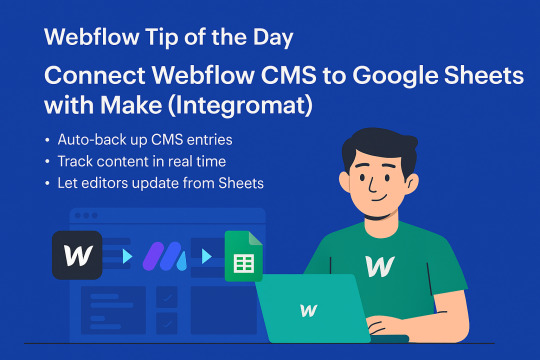
Webflow Tip of the Day
Connect Webflow CMS to Google Sheets with Make (Integromat)
Want to automate your content workflow? Use Make (formerly Integromat) to connect Webflow CMS to Google Sheets.
This allows you to:
Auto-backup CMS entries to a spreadsheet
Track blog posts, products, or team updates in real time
Enable content editors to update content from Google Sheets
How to Do It:
Create a scenario in Make.com
Add Webflow and Google Sheets as modules
Authenticate your Webflow API and select your CMS Collection
Choose actions like “Watch Records” in Google Sheets and “Create Item” in Webflow
Schedule it or run on form submission
Bonus Use Case:
Reverse the flow, update a CMS item when a Google Sheet row is edited.
No-code automation saves hours of manual entry and empowers your non-technical clients, too!
📌 Connect With Me:
🌐 Portfolio: https://webflowwork.com/
🎯 Upwork: https://bit.ly/4iu6AKd
🎯 Fiverr: https://bit.ly/3EzQxNd
#WebflowTips #NoCode #WebflowCMS #Automation #Make #Integromat #GoogleSheets #WebflowDeveloper #ClientWork #Productivity
#webflow#freelancewebdeveloper#web design#web development#webflowdesign#webflowlandingpage#webflowexperts#website#nocode#ui ux design
0 notes
Text
Stop Losing Leads: How ContactFormToAPI Ensures Instant API Sync
In today’s fast-paced digital world, every second counts—especially when it comes to capturing and managing leads. Businesses invest heavily in marketing campaigns to drive traffic to their websites, but often overlook a critical step in the sales funnel: ensuring form submissions are instantly routed to CRMs, APIs, and automation tools.
If you’re relying on manual methods, email notifications, or delayed workflows, you may already be losing valuable leads. That’s where ContactFormToAPI comes in—a powerful solution to instantly sync your contact form submissions with any REST API or CRM.
In this blog, we’ll explore the importance of instant lead capture, the dangers of lead loss, and how ContactFormToAPI can automate and secure your data flow.
The Hidden Problem: Delayed or Lost Leads
Imagine a potential customer filling out your website’s contact form. They’re interested, ready to buy or inquire, and waiting for a response. But if that form submission isn’t sent to your sales CRM—or worse, gets lost in email—you might never hear from them again.
Common causes of lead loss include:
Forms that only send email notifications
Delayed integrations with third-party tools
Inconsistent data syncing between platforms
Lack of API connectivity with your CRM or automation stack
Each of these issues creates a bottleneck in your lead generation funnel and ultimately costs you business.
Why Instant API Sync Matters
Speed is the key to conversion. According to research, contacting a lead within the first 5 minutes increases conversion chances by up to 9 times. But this only works if your form data reaches your tools instantly.
Instant API sync enables:
Real-time lead capture and nurturing
Immediate follow-ups via email or CRM triggers
Accurate data logging across your stack
Better automation and analytics
That’s why syncing your contact form data with your backend systems through APIs is essential for any modern business.
Meet ContactFormToAPI: Your Form Automation Ally
ContactFormToAPI is a no-code tool that bridges your website forms and any REST API. Whether you use WordPress (WPForms, Contact Form 7), Webflow, Wix, or a custom site, this tool enables you to send data to your CRM, Google Sheets, email marketing tools, or any REST API.🚀 Key Features:
Instant form-to-API sync
No code setup for most platforms
Support for GET, POST, PUT methods
Custom headers, tokens, and authentication
Zapier and Pabbly Webhook compatibility
Works with WPForms, Elementor, CF7, and more
With ContactFormToAPI, there’s no need to worry about missed leads or complex development work. You configure your endpoint, map your form fields, and the tool handles the rest—instantly.
Real-World Use Cases
Let’s break down how businesses across industries use ContactFormToAPI to streamline their operations:
1. Marketing Agencies
Connect contact forms to HubSpot, Mailchimp, or ActiveCampaign instantly to launch follow-up campaigns.
2. E-commerce Stores
Send contact or inquiry form data directly to fulfillment or order management APIs.
3. Healthcare Clinics
Automatically sync appointment request forms to EHR systems via secure API calls.
4. B2B Service Providers
Push lead data into Salesforce or Zoho CRM for real-time lead assignment and nurturing.
5. Educational Institutions
Route student inquiries to Google Sheets, CRM, or email workflows without delay.
How It Works
Step 1: Choose Your Form
Whether it’s WPForms, Contact Form 7, Elementor, or any HTML form, you can use ContactFormToAPI with ease.
Step 2: Configure API Endpoint
Add your destination API endpoint URL, method (POST/GET), and required headers or tokens.
Step 3: Map Your Fields
Use the form field names and map them to your API’s field structure. You can also add static data or use smart tags.
Step 4: Test and Go Live
Use the built-in testing tool to validate the integration. Once confirmed, every form submission will be sent to your API instantly.
Security and Reliability You Can Trust
ContactFormToAPI ensures data is transmitted securely using HTTPS, with support for authentication headers, bearer tokens, and custom headers. You can also:
View logs of API calls
Retry failed requests
Get email notifications on integration errors
This reliability helps ensure that no lead is lost due to technical glitches.
⏱ Save Time and Cut Manual Effort
If your current workflow involves manually exporting form data or checking inboxes, ContactFormToAPI can save you hours every week. With automation in place:
Sales teams can respond faster
Marketers can trigger nurturing emails automatically
Business owners can track performance with confidence
��Integrates With Everything
The tool is designed to be platform-agnostic, meaning it works with:
Any REST API (Zapier, Pabbly, Integromat, etc.)
Any CMS (WordPress, Webflow, Wix, Squarespace)
Any CRM (HubSpot, Salesforce, Zoho, etc.)
Google Sheets, Airtable, Notion, or email tools
This flexibility makes ContactFormToAPI ideal for startups, agencies, and enterprise teams alike.
Bonus: Tips for Better Lead Capture
Even with instant API sync, it’s important to ensure your lead capture strategy is optimized. Here are a few tips:
Keep your form simple (3–5 fields max)
Use smart field validation
Add form analytics to track conversion rates
Offer an instant confirmation message or email
Regularly test your form-to-API setup
Final Thoughts: Stop the Leak, Start Growing
Lead generation isn’t just about getting people to your website—it’s about capturing them efficiently and following up without delay. If you’re still relying on email notifications or manual processing, you’re likely leaving money on the table.
ContactFormToAPI offers a fast, reliable, and code-free way to ensure your contact forms talk directly to your tools, whether it’s a CRM, Google Sheet, or custom backend API.
Ready to Stop Losing Leads?
Visit ContactFormToAPI.com to set up your form integration in minutes. Try the free version or explore premium features for more complex workflows.
0 notes